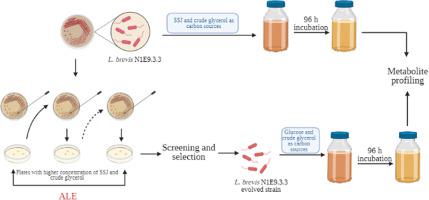Journal of Environmental Chemical Engineering ( IF 7.4 ) Pub Date : 2021-07-21 , DOI: 10.1016/j.jece.2021.106086 Maria Paul Alphy 1, 2 , Kodakkattil Babu Anjali 1 , Narisetty Vivek 1, 2, 3 , Banjagere Veerabhadrappa Thirumalesh 1 , Raveendran Sindhu 1 , Arivalagan Pugazhendi 4 , Ashok Pandey 5, 6 , Parameswaran Binod 1

|
Sweet sorghum juice (SSJ) is considered as an ideal complement for carbon supplement in ethanol fermentation for its ease of cultivation. Extraction of fermentable sugars from the sweet sorghum is very simple in comparison to lignocellulosic biomass. Hence sweet sorghum is a suitable candidate as a feedstock. In the present study, batch fermentations were carried out using Lactobacillus brevis NIE9.3.3, a facultative anaerobe, isolated through onsite enrichment technique to produce 1,3-propanediol and other co-metabolites, in glucose-glycerol co-fermentation. To make the process more sustainable, the glucose supplemented in the production media was replaced with SSJ. The supplementation of 40 g/L sorghum juice and 40 g/L crude glycerol in the production media resulted in the titre of 25.9 g/L 1, 3-PDO with a volumetric yield of 0.64 g 1,3-PDO/g glycerol. Adaptation of the microorganisms and cultivation under controlled conditions of temperature and substrate concentrations followed by selection was carried out, that is, adaptive evolution. Among the adaptively evolved strains, PD 20.100 has displayed better performance and increased the titres up to 38.4 g/L with a volumetric yield of 0.64 g 1,3-PDO/g glycerol. The industrial applicability of the fermentation process was checked in pilot scale and the production yield was comparable with that of flask scale. The utilization of agricultural and biodiesel industrial waste for the production of 1,3-PDO by a GRAS organism and the strain improvement through ALE for better utilization and conversion of substrates indicates the novelty of this work.
中文翻译:

甜高粱汁作为替代碳源和短乳杆菌NIE9.3.3 在甜高粱汁和生物柴油衍生粗甘油中的适应性进化以提高 1, 3 丙二醇产量
甜高粱汁 (SSJ) 因其易于栽培而被认为是乙醇发酵中碳补充的理想补充。与木质纤维素生物质相比,从甜高粱中提取可发酵糖是非常简单的。因此,甜高粱是合适的候选原料。在本研究中,使用短乳杆菌NIE9.3.3(一种兼性厌氧菌)进行分批发酵,通过现场富集技术分离,在葡萄糖-甘油共发酵中产生 1,3-丙二醇和其他共代谢物。为了使该过程更具可持续性,生产培养基中补充的葡萄糖被 SSJ 取代。40 g/L 高粱汁和 40 生产培养基中的 g/L 粗甘油的滴度为 25.9 g/L 1, 3-PDO,体积产率为 0.64 g 1,3-PDO /g 甘油。在受控的温度和底物浓度条件下进行微生物的适应和培养,然后进行选择,即适应性进化。在适应性进化的菌株中,PD 20.100 表现出更好的性能,将滴度提高到 38.4 g/L,体积产量为 0.64 g 1,3-PDO /g甘油. 在中试规模中检验了发酵过程的工业适用性,并且产率与烧瓶规模相当。利用农业和生物柴油工业废物通过 GRAS 生物生产 1,3-PDO 以及通过 ALE 进行菌株改良以更好地利用和转化底物表明了这项工作的新颖性。











































 京公网安备 11010802027423号
京公网安备 11010802027423号